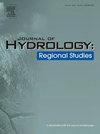墨西哥西北部山区网格降水数据集评估
IF 4.7
2区 地球科学
Q1 WATER RESOURCES
引用次数: 0
摘要
研究区域墨西哥西北部西马德雷山脉复杂的山区地形。研究重点在传统雨量计覆盖范围有限的地区获取高分辨率降水数据是一项重大挑战。网格降水(GP)数据集(包括基于雨量计、卫星和再分析产品)提供了一种潜在的解决方案,但在地形复杂、降水模式错综复杂的地区,这些数据集的可靠性仍不确定。本研究全面评估了四个 GP 数据集(AORC、CHIRPS、Daymet 和 ERA5)在估计降水量方面的性能。结果表明,Daymet 和 AORC 分别是日和月时间尺度上最准确的 GP 数据集。在较长的时间尺度上,所有数据集的准确性都有所提高,但在潮湿的夏季季风月份和极端事件期间,Daymet 的表现相对较好。地形海拔对数据集的整体准确性影响很小,但随着海拔的升高,降水检测的准确性略有提高。这项工作为了解 GP 数据集在复杂地形和地貌对流降水地区的优势和局限性提供了宝贵的见解,为类似地区的气候和水文研究提供了实用的成果。本文章由计算机程序翻译,如有差异,请以英文原文为准。
Evaluation of gridded precipitation datasets in mountainous terrains of Northwestern Mexico
Study region
The complex mountainous terrains of the Sierra Madre Occidental in northwestern Mexico.
Study focus
Acquiring high-resolution precipitation data in regions with limited conventional rain gauge coverage poses significant challenges. Gridded precipitation (GP) datasets, including gauge-based, satellite, and reanalysis products, provide a potential solution, but their reliability in areas with complex terrain and intricate precipitation patterns remains uncertain. This study comprehensively evaluates the performance of four GP datasets—AORC, CHIRPS, Daymet, and ERA5—in estimating precipitation. The evaluation was conducted at a daily, monthly, and seasonal timescale, further analyzing extreme precipitation, the influence of elevation, and spatial averaging across hydrologic basins, using as reference the NERN rain gauge data from 2002 to 2004.
New hydrological insights for the region
Results indicate that Daymet and AORC are the most accurate GP datasets for daily and monthly timescales, respectively. All datasets improve in accuracy over longer timescales but face challenges during the wet summer monsoon months and extreme events, with Daymet performing relatively better. Terrain elevation had a minimal impact on overall dataset accuracy, though a slight improvement in precipitation detection was noted as elevation increased. This work provides valuable insights into the strengths and limitations of GP datasets in regions with complex terrain and orographically-forced convective precipitation, offering practical outcomes for climate and hydrologic studies in similar regions.
求助全文
通过发布文献求助,成功后即可免费获取论文全文。
去求助
来源期刊

Journal of Hydrology-Regional Studies
Earth and Planetary Sciences-Earth and Planetary Sciences (miscellaneous)
CiteScore
6.70
自引率
8.50%
发文量
284
审稿时长
60 days
期刊介绍:
Journal of Hydrology: Regional Studies publishes original research papers enhancing the science of hydrology and aiming at region-specific problems, past and future conditions, analysis, review and solutions. The journal particularly welcomes research papers that deliver new insights into region-specific hydrological processes and responses to changing conditions, as well as contributions that incorporate interdisciplinarity and translational science.
 求助内容:
求助内容: 应助结果提醒方式:
应助结果提醒方式:


